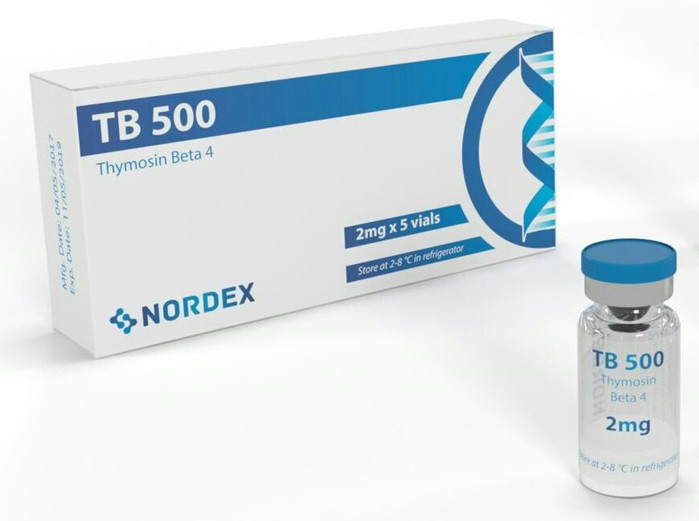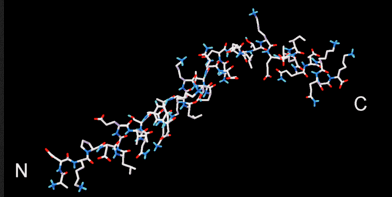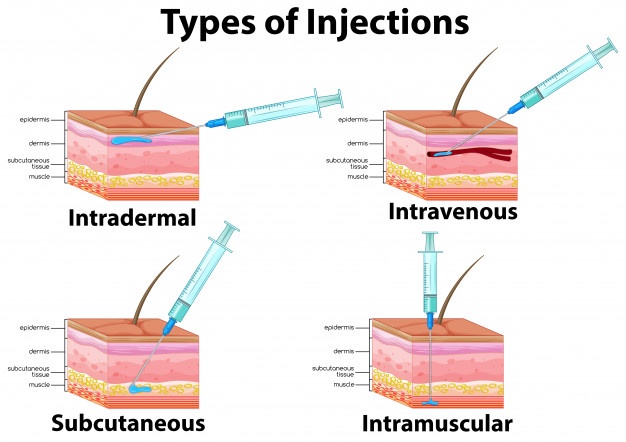
Tb-500 is a synthetic version of natural thymosin beta 4 that occurs in the body. It is a peptide that has a multitude of bodily benefits, primarily – muscular healing. Originally sold purely for veterinary use, this synthetic peptide also works wonders for humans. It’s linked to impressive muscle recovery, generation of tissue fibres, red blood cell production, and new cell migration. Working quickly and effectively, it helps the body heal from injury.
Before we get started, a word of warning – this is a substance banned by the World Anti-Doping Agency, so do not use it if you’re participating in professional sport!
What is TB-500?
If you have acute pain which needs alleviating, one of the best options is to periodically inject a TB-500 dose. The substance is a synthetic thymosin beta 4 peptide that will help you quickly heal from wounds, bodily pain, or muscle damage. In particular, it has gained notoriety for its repair of muscle, tendons, heart, skin, and eye injuries. The synthetic compound is much related to its parent beta 4, performing the same sort of task in the body, but thymosin beta4 is not as easily produced due to its size. The TB-500 peptide is a preferable option because it can be easily manufactured.
The uses of this peptide are broad and can be used in the following:
● Repair of soft tissue
● Healing from athletic injury
● Ligament, tendon or muscle repair
● Treatment of Multiple Sclerosis
● Treatment of spinal cord injury
● Treatment of eye disorders
● Improvement of immune support
● Use in the repair of chemical burns
● Reducing inflammation
Thymosin Beta: A Brief Overview

There is a lot of information online about different peptides, with claims that they can cure a number of ailments. You may have read discussions on the likes of topics such as TB-500 vs BPC-157: so what is thymosin beta? In short, it’s a protein encoded by the TMSB4X gene in humans consisting of 43 amino acids, with the following sequence:
SDKPDMAEI EKFDKSKLKK TETQEKNPLP SKETIEQEKQ AGES
You can find this protein in all bodily tissues and cells, with the exception of red blood cells. What’s so important about this protein is that scientists regard it as the main G-actin sequestering peptide, actin being the most abundant protein found in our cells. Thymosin beta is also angiogenic, promoting the growth of vasculature in the body.
Thymosin beta 4 benefits the body by promoting adhesion, cell migration, cell proliferation, wound healing, scarring healing and it reduces inflammation.
How Does TB-500 Work?
Tb-500 and thymosin work by upregulating the proteins that build bodily cells, primarily actin, a protein that forms muscle cell filaments and is involved in the metabolism of numerous cells. Actin is a cellular protein critical to cell mobility, muscular contraction, and signaling between cells. Upregulation results in improved cell growth, healing, cell proliferation, and cell migration. Studies from Wei et al. show that the peptide can even reduce pulmonary hypertension and hypertrophy in the heart.
The substance increases angiogenesis (blood vessel formation) around damaged tissues, expanding new blood vessel pathways and reducing inflammation – all of this results in faster wound healing. When you research and read peptides reviews online, you’ll notice the thing that sets Tb-500 apart is its low molecular weight. This allows it to travel long distances through bodily tissues, targeting injured areas much quicker and easier than many other peptides.
TB-500 Benefits
If you’re wondering “what does thymosin do?”, there are a wide range of benefits documented in scientific research:
● An improved cell migration towards the site of injury – tb-500 results in an increase of cell migration around the body, helping the body repair its tissues quickly and effectively.
● Reduces inflammation – a study by Sosne et al. found that the compound is a novel anti-inflammatory agent, producing a diverse array of healing properties. The research has also found that the substance can suppress apoptosis.
● Reduction in pressure ulcers – double-blind clinical trials have found the substance can reduce the intensity of pressure ulcers when administered topically.
● Greater endurance – because wounds heal faster and inflammation decreases, people feel healthier and have greater endurance. This is especially noted among athletes.
● Brain function recovery – studies found in the National Library of Medicine link thymosin beta-4 and related peptides to the reduction of brain injury. The anti-inflammatory properties of thymosin reduce traumatic brain injury and promote angiogenesis.
● Promotes wound healing – tb 500 creates an expression of matrix metalloproteinases. These can lead to increased wound healing in muscles all around the body.
How to Use TB-500?
When looking at peptides reviews, you’ll find that tb 500 is most commonly administered with an injection into the body. The process is relatively simple and effective – all you need to do is determine the correct dosage, gather required materials, and follow basic steps to inject correctly.
Dosage and Cycle Duration
You calculate TB-500 dosage based on the damage or injury sustained to your body, and people normally use between 4 – 8 mg of the substance on a weekly basis during an initial “loading phase”. After this, you can keep taking the substance indefinitely every two weeks for as long as you need to. Usually, the effects are known to wear off around 2 weeks after injection.
The correct tb 500 dosage for humans is based on weight. For a 90kg person, the recommended dose is 7.66 mg per week for a six week period. You can derive this by calculating using a formula, based on greyhound doses, according to MediVet (a company producing tb 500) and common scientific practices.
Human equivalent dose (mg / kg = Animal dose mg / kg) × (WeightAnimal [kg]/Weighthuman [kg])
| TB-500 loading phase | TB-500 maintenance phase | |
| Duration | 4 – 6 weeks | Indefinite |
| Dosage | 4 – 8 mg per week | 2 – 6 mg bi-weekly |
| Frequency of injection | 2 mg for each injection, taken 2 – 4 times every week (dependent on your total weekly dosage) | 2mg for each injection, taken 2 – 3 times every week (depending on your total bi-weekly dosage) |
How to Mix TB 500?
Supplier peptide websites often sell TB-500 in a powdered form, and you can often find it commonly marketed under the name of Thymosin Beta 4. You need to mix the constituted powder with bacteriostatic water. Once you draw the mix into an insulin syringe, you can inject it how you see fit, either subcutaneously, intramuscularly, or intravenously. It’s a relatively simple process, condensed into three simple steps.
Supplies Needed For Injection
Relatively few supplies are needed, but do make sure you have the following:
● Your TB-500 powder
● Insulin syringe
● Bacteriostatic water
● Alcohol-based swab
Bacteriostatic water is a must here – you can’t use ordinary water from the tap. The process needs to be kept as sterile and clinical as possible to avoid any possible risks of contamination or infection.
Mixing TB-500: A Step-by-Step Guide
- Remove the lids from your containers of water and powder.
- Clean both the rubber stopper of the TB-500 container and the top of the bacteriostatic water vial with your alcohol swab, then wait till the alcohol dries off completely before proceeding to the next step.
- Fill your syringe up with water, slowly injecting it into your TB-500 bottle. Let it slide down the sides of your container and avoid spraying directly onto the powder. Take your time with it and don’t rush or you could damage the powder itself. You will need to repeat this process around three times to fill up the whole bottle.
The process is now complete. If it sits at room temperature or has direct exposure to sunlight then it will go bad. Keep the substance in your freezer or refrigerator to preserve it before use.
How to Inject TB-500

There are three main ways of injecting TB-500. Before engaging in injection, double-check that you’ve cleaned the container with your swab to ensure minimal contamination.
Intramuscular injection – the most difficult of methods. You will need to stab your muscle as close to where the injury occurs. The needle needs to be inserted further than under the skin, so a stabbing motion is required here.
Subcutaneous infection – an easier method whereby you pinch the area of skin and push your needle through. Make sure you inject as close to the injury as you can.
Intravenous injection – your needle is inserted into a vein, commonly one that’s near your elbow, wrist or the back of your hand. It can be a tough method, especially for first-timers. We would recommend getting medical supervision with this method.
After injection, massaging the area will help the substance kick into the tissues, improving the effectiveness and absorption by the body.
Tb 500 side effects and risks
There are relatively few tb-500 side effects, but it is essential to take note of recent studies that have found a link between thymosin and cancer. Studies carried out by Zhang et al. show a link between thymosin and cancer cell growth, increasing the likelihood of pancreatic cancer in particular.
However, research into thymosin beta 4 side effects and cancer is disputed in academia. Doctors initially found higher amounts of thymosin in cancerous tissues and assumed that thymosin beta 4 results in cancer cell production, but many believe that its presence is instead a result of increased white blood cell production. The presence of this substance may therefore indicate higher white blood cell growth as opposed to an increase in cancerous tissues. Circumstantial evidence also points to feelings of lethargy after injecting the drug, but this is yet to be widely documented in the scientific literature.
How to Store TB-500?
Make sure that you store your peptide powder and reconstituted TB 500 between a temperature of 36 and 46°F. Under this temperature, a typical vial of un-constituted substance can last for two years, but a temperature of 98°F can also work well for around 90 days of storage. Once you reconstitute the parlor, it should be used within eight days and you do not want to freeze the peptide at any point.
Conclusion
With all the best peptides available online, there is a lot of conclusive evidence around TB 500 and bodily repair. We hope you’ll take away some of the facts we’ve presented so that you know exactly what to look for. There are several different uses for TB-500, most notably in repairing bodily tissue, helping to reduce muscle damage, and rid the body of inflammation. It is an exciting substance that offers promise for those who suffer from pain and damaged tissue. The future’s bright and a wide range of new clinical applications are being investigated other than using TB-500 for muscle growth, including the use of TB-500 in repairing the spinal cord and bones. The substance is even being considered for the treatment of aging, viral infections, kidney disease, and liver failure.
Who knows what exciting TB-500 technologies will be developed soon. Make sure you keep on top of all TB-500 reviews 2020 has to offer and best of luck in your research.
Article compiled using information from the following sources:
- https://en.wikipedia.org/wiki/Thymosin_beta-4
- https://a4m.com/assets/pdf/covid-19-resources/Thymosin%20beta%204%20prof%20monograph.pdf
- https://pubmed.ncbi.nlm.nih.gov/2677145/
- https://pubmed.ncbi.nlm.nih.gov/26096726/
- https://www.ncbi.nlm.nih.gov/pmc/articles/PMC4804402/
- https://www.ncbi.nlm.nih.gov/pmc/articles/PMC2930015/
- https://pubmed.ncbi.nlm.nih.gov/26096726/
- https://zenodo.org/record/1230768#.XZZJPfxKgUs
- https://www.jbc.org/content/early/2014/05/14/jbc.M113.529966.full.pdf
- https://pubmed.ncbi.nlm.nih.gov/25412097/
- https://www.clinicaltrials.gov/ct2/show/NCT00382174
- https://www.ncbi.nlm.nih.gov/pmc/articles/PMC2701135/
- https://www.ncbi.nlm.nih.gov/pmc/articles/PMC3547647/
This article is medically reviewed and approved by Jonathan Ritter, Pharm.D., Ph.D., MIMFA, Founder & CEO at Eneuvos Bionutriceuticals.
